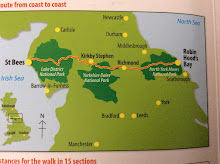 |
| New Farm sunrise |
 |
| City skyline. |
In the last week we have had family arrive from the UK bringing our grandson of 6 months for his first Aussie visit, AND a new grandchild born in Brisbane, so rather too much excitement for long walks.
However, we have still managed 7 good training mornings since the last blog.
In the early morning light hot air balloonists look down on 2 'older' backpackers in boots, sharing the paths and river with bike riders, commuter bikers (going too fast and too near us on shared paths) runners, dog runners and walkers, boot campers, walking and jogging pram pushers, yoga posers, rowers, paddlers, dragon boaters, meditaters, boxercisers, outdoor gym workouters, spin classes in the park, skaters, bladers, scooters, kick bikers, or those just enjoying the Storey Bridge climb as the sun rises.
 |
| The city reach. |
 |
| Morning light New Farm |
 |
| Storey Bridge. |
 |
| Our new Kurilpa Bridge. |
Thoughts have turned to packing and walking needs; we have enough goodies to set up our own Kathmandu franchise (it's their 'permanent' sale that entices us in to buy that last little towel, boot liner or head torch)! Now for packing decisions.............
 |
| city cat. |
In case you haven't realized, the 3 big elements for the modern day pilgrim are WALKING, SLEEPING and EATING! The first two are taken care of, so now a little on food!
I've been having a bit of fun researching food and specialties along the route.....my excuse is that it is helping my Spanish!
Is it coincidental that Spanish tapas bars are popping up all over Brisbane at the moment? It really is the flavour of the month!
SPANISH CHEESES.
Creamy Curds are very common in farm kitchens all over Spain.
Queso Fresco is delicious with honey or served with Pimenton de la Vera, olive oil and oregano for savoury flavours.
Manchego is a hard sheep's milk cheese.
Torta del Casar is a delicious, oozing soft cheese made from Merino milk. It is made in Extramadura and its supply is limited, but it comes highly recommended!
Zamorana is a special sheep's cheese made in Zamora. Its rind is made by regular dipping in E.V.O.O.
SPANISH HAM.
Spain probably produces the best air-dried ham in the world.
Jamon Iberico. Made from the black-hoofed Iberian pig, reared in Extramadura, and a descendant of the Mediterranean wild boar. It is graded according to amount of bellota (acorns) in their diet. They are often seen in the dehesa (wooded pastures) in November and December, searching for acorns.
Jamon Serrano. Made from the modern breed of white pig. The best pigs come from the mountains, hence the name.
PIMENTON de la VERA.
Pimenton is the Spanish word for paprika, which came originally from Mexico as a gift to the King and Queen of Spain.
The monasteries in Extramadura were given the responsibility to grow the peppers with the monks at Yuste in the La Vera valley producing the best paprika.
Dotted around the fields of peppers are the two-storey smoke houses. Peppers hang from the rafters and are smoked by the holm oak fires from the fires below.
The smoked paprika is commonly used in chorizo, and the powder spice is a must for Spanish cooking. Three types are used: dulce (sweet and mild), agridulce (bittersweet and medium hot) and picante (hot).













